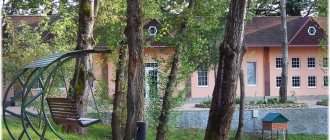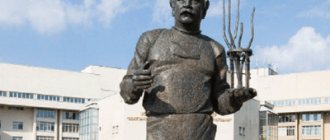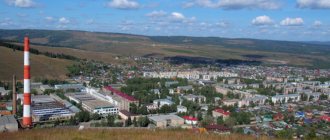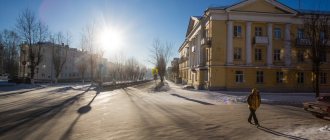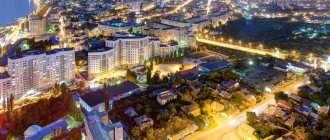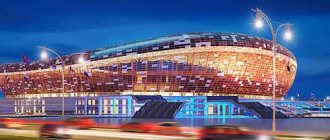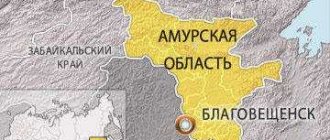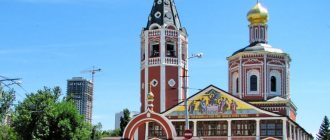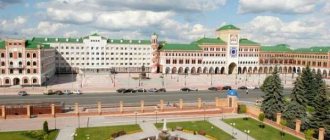Beloretsk against the backdrop of Raspberry Mountain
Sergey Sinenko
History of the city of Beloretsk (Bashkiria)
Beloretsky district is the largest in the republic. There is no end to it. Huge mountains, forests, stone pillars, mountain rivers, deposits of iron ore of rare purity and a small amount of impurities, deposits of gold, ocher, marl, shale, chromite... How to arrange all this? There is work here for two hundred, no, five hundred years! The entire history of Belorechye is determined by the nature of the vast space that people inherited.
Everything in Beloretsk suggests that it is a large metallurgical center. When entering from Ufa you see a giant elk on the right, on the left there is a monument to the metallurgist and a stele with the inscription “Beloretsk is a city of metallurgists. 1762". And in the city itself, reminders of this are found at every step.
But the city became different. He has changed. And the people became different. There are no more proud metallurgists. Because ore mining has stopped and steel smelting has almost stopped. Because the words and concepts that previously defined the life of the city have become anachronistic: “blast furnaces”, “open hearths”...
Now I have bought the plant. And a new word appeared in the speech of Beloretsk residents - “offshores”. It can be heard in the local administration, and in the newspaper “Beloretsky Rabochiy”, and from random passers-by on the street.
At first I was surprised how this could be, since the company’s products have defense or semi-defense significance. “Not anymore,” they reassured me. “The plant has not been working for the defense industry for a long time.”
Old water tower in Beloretsk outside and inside. Photo by Sergei Sinenko
Sights and memorable places
The beautiful city of Beloretsk in Bashkiria is famous for its attractions. Here you can visit a museum, see monuments, and also visit unique natural places. Waterfalls, rocks, mountains, rivers and forests - all this can be enjoyed in Beloretsk, breathing clean air and contemplating untouched nature. There is also a nature reserve here that cannot be ignored. But everything will be told in order in the description of the sights of Beloretsk.
From the Red Partisans to Mratkino
I examine another city landmark - a five-hundred-meter wooden bridge connecting the shores of the factory pond. Many Beloretsk residents go to work along it. The bridge is periodically repaired, but its design features have been preserved, so it has not lost its flavor.
Here is the northern outskirts of Beloretsk. The city blocks end; the garden plots “BMK”, “Urozhay” and “Veteran”, located near the majestic Mratkina Mountain, stretch along the road.
Beloretsk city pond, view from the old water tower. Photo by Sergei Sinenko
A new turn in the development of the city is associated with this mountain. In recent years, a ski center has been built here - a ski lift, an artificial snowmaking system for the slopes have been installed, and in the future the construction of a stadium and biathlon tracks. The main goal is to revive the Olympic reserve school, which was previously located in the city. The influx of tourists to Beloretsk in the winter season is significant, and Mratkino is located very close to Beloretsk. Together with other tourist centers, a large ski complex is emerging around the city.
But they show me photographs of a city pond - large brown-red spots on the water.
“Drains into Belaya spoil the environment, and this cancels out the very idea of creating a tourist area here,” says Tatyana, who is closely dealing with the problem. — The management of the plant says: “We have bream swimming!” They swim. But in fact, the pond has not been cleaned for 150 years out of the 250 that it has existed. The pickling department of the plant is the workshop that produces the largest amount of hazardous waste. The “travilka” releases all sorts of rubbish into the city pond. The plant faces a lawsuit for 400 million.
What are we talking about? The trial began this summer. The Arbitration Court of Bashkiria is considering a claim by the regional department of the Federal Service for Supervision of Natural Resources against BMK in the amount of 408 million rubles for the damage it caused to the Belaya River. Rosprirodnadzor claims that wastewater was discharged from the plant’s treatment facilities with a multiple, tens of times, excess content of harmful substances.
Steelmaker Mashevsky
You may be interested in: Aeroflot hand luggage size. New rules for carrying baggage and hand luggage on planes
Steelmaker Mashevsky is a monument to the metallurgists of Beloretsk, which stands at the entrance to this wonderful city. The metallurgical plant is what Beloretsk is famous for. Metallurgy here has long reached a high level, in honor of which this monument to Anatoly Mashevsky was erected about forty years ago. This landmark of the city of Beloretsk symbolizes the courage, firmness, strength and hard work of the Ural people.
Cultural life of the city of Beloretsk
When townspeople and travelers come to Beloretsk, they often visit the Art Gallery and the local Palace of Culture.
Art Gallery
The Art Gallery opened its doors in September 1980, becoming the first such institution in Bashkiria. Its status changed several times, in the 1990s it became a branch of the Bashkir Art Museum, and since 2006 it has been a municipal institution.
The Art Gallery is not only an exhibition space, but also a venue for cultural events, creative meetings with local and “all-Russian” celebrities, and musical evenings.
Monument to Beloresk metallurgists
Another significant place in the city is the monument to the Beloretsk metallurgists, which is part of the memorial complex. A huge metal stele stands in the center, glorifying metallurgical heroes. Here on the marble wall are engraved the names of almost a thousand engineers, workers, metallurgists who fought and gave their lives for their homeland, for their families, for their city.
Instead of a “sip of freedom”
History is always distinguished by divergence of plans and results. It happens that the errors are large. But in the case of Beloretsk they are catastrophic. Both the moral and economic meaning of the transformations that have taken place in recent years have turned out to be completely opposite to the original goals.
Having received a “sip of freedom,” people were drawn into deception, which resulted in the destruction of everything that was dear to them. Metallurgists, seemingly proud people, allowed everything to be done to them that the offshore government wanted to do to them. One can only wonder what forces prevent people from dying.
Today, greedy capital has made the lives of several generations of Beloretsk residents meaningless. There is a feeling of guilt towards those who lived before us for the chaos that their descendants allowed to create on themselves. Where are the former metallurgists?
Avenue of Heroes
Like almost all cities of the former Soviet Union, Beloretsk has an Alley of Heroes. No one is forgotten and nothing is forgotten by the citizens of this city. People remember, respect and thank their ancestors for the victory in the Great Patriotic War. The Eternal Flame has been burning in front of the memorial since May 9, 1985. Flowers are laid here to honor the memory of heroes. The plaque depicts words of gratitude. To feel the history, remember and thank the heroes, it is worth visiting this place.
Giant company
Of course, it’s difficult to compete with. Both by Russian and international standards, it is a giant in the mining and metallurgical industries. And he makes gigantic deals. The whole country heard about some of them.
In 2008, during a meeting in Nizhny Novgorod regarding rising prices for metals and coal, Vladimir Putin spoke very harshly in relation to its owner Igor Zyuzin personally. “We are so respected,” said Vladimir Putin. — By the way, we invited the owner and head of the company, Igor Vladimirovich Zyuzin, to a meeting, but he suddenly fell ill. Meanwhile, it is known that in the first quarter of this year the company sold raw materials (coal) abroad at prices two times lower than market prices, and therefore world prices. Where is the margin, in the form of taxes for the state?”
The historical building of the plant administration in Beloretsk. Photo by Sergei Sinenko
“Of course, a disease is a disease,” noted Vladimir Vladimirovich and advised the owner of Mechel to get well quickly, “otherwise a doctor will have to be sent to him and cleaned up all these problems.” Putin has never spoken so harshly about any businessman except Mikhail Khodorkovsky. He demanded that both the Investigative Committee of the Prosecutor General’s Office and the Federal Antimonopoly Service look into Mechel’s export supplies of raw materials. As experts noted, the company sold coal to its “daughter” offshore at reduced prices, and it, in turn, sold it at market prices.
This is how it turned out that “offshore”, a word not commonly used in everyday speech, is heard on the streets in Beloretsk. It is not because of a good life that the townspeople have become so advanced. Yes, Mechel is a giant company. But the higher its social responsibility. What did she give Beloretsk? What did you do for the city?
Water tower
An amazing memorial site of this city is the water tower, built more than a hundred years ago. For a very long time it was the tallest building in Beloretsk; from it you could even see the outskirts of the city and the villages surrounding it. True, a modern person will not be impressed by the height of this tower - it barely reaches twenty meters. But a hundred years ago this was a significant figure. In the 1950s, the tower ceased operation. The last time water was supplied from this water tower was in 1956, and now it is only a landmark of Beloretsk, a memorable place for the residents of this city.
Highly scientific project ASUSP
How many times have I been convinced: every event in life gives a wave that, if not now, then later, years later, will definitely overtake you. So it is with Beloretsk. I haven’t been to the city for ages, but it’s not a stranger to me, moreover, I feel a certain inner kinship with it. The fact is that my first place of work after graduating from university was the “propaganda and agitation laboratory” under the leadership of Professor Dzhaudat Makhmudovich Gilyazitdinov, and my first work site was the Beloretsk Metallurgical Plant.
At that time, the idea of science as the basis of politics was actively being introduced. Doctrinal thinking claimed the scientific nature of its dogmas and decisions made on their basis, and failures were explained by inattention to “effective” theories and methods. When the food supply in Beloretsk deteriorated in the early 1980s, metallurgists announced this openly and loudly, so that both Ufa and Moscow heard.
Unable to solve food problems radically, the republican regional committee of the CPSU decided, firstly, to organize constant monitoring of the situation, and secondly, to transfer the management of work collectives to a modern basis using computers that had just emerged at that time.
Thus, in the “propaganda laboratory”, the ASUSP project, an automated system for managing social processes, arose that was fantastic from beginning to end. At the metallurgical plant they planned to install a giant computer (weighing several tons), which would process thousands of questionnaires daily, recording the opinions of the working team. Electronics should develop recommendations and send them via cable to the director of the plant and to the city party committee of Beloretsk.
However, they did not take into account the most important thing. Opinions of metallurgists themselves. It was assumed that the questionnaires would be filled out by workers, foremen, foremen, shop managers - in general, everyone, right down to the director of the plant, Vadim Kulesha. But the workers simply refused to participate in the surveys. “We don't need this. All this was invented to enslave us even more,” they said in the workshops. That's all. It is for this reason that the “highly scientific” project was covered with one big blanket...
Let me note that personally, after what happened, I only respected the local people even more. It was a working world, complete and orderly in its own way.
The metallurgist in stone is a monument to past and present generations of Beloretsk residents. Photo by Sergei Sinenko
Beloretsk Museum of History and Local Lore
He began his activities about sixty years ago. The museum's collection exceeds 13 thousand exhibits. By visiting it, you can see the entire history of this city since ancient times. Here you can see interesting exhibitions, visit two exhibition halls, and purchase brochures and booklets that briefly provide basic information about the city. Museum workers conducting excursions will tell you about this. There are four main topics covered here:
- Natural, archaeological and ethnographic history of Beloretsk.
- Factory stories. You can learn about the work of serfs and see samples of manufactured products.
- History of the 20th century. The pre-war, war and post-war periods are covered here.
- Minerals. Here is a collection of ores, natural resources, and stones.
A visit to this Beloretsk attraction (photo above) will be very interesting not only for local residents, but also for tourists.
Beloretskaya narrow gauge railway
I'm walking along Zheleznodorozhnaya Street. The name has already become history. Here, on the territory of the plant, began the main transport artery of Belorechye - a narrow-gauge railway, which was recently dismantled.
“The railway was unique, without it the region was orphaned,” says Elena Bezrukova, chairman of the street committee of the Zarechny district.
People in the city talk about this with great pain. It's clear. What has united the inhabitants of Belorechye for the last hundred years? What determined their connection with the outside world? Narrow gauge railway! It was she who was the core that created the community of Beloretsk residents with the residents of Tirlyan, Tukan, Inzer, Ishli, Arshinsk, Dvoinisha and other numerous railway stations and nearby villages. Connecting Beloretsk with the Zaprudovka station near Katav-Ivanovsk, it gave the mining world of the Southern Urals access to the industrial centers of the Middle Urals, Western Siberia and the Volga region.
This road was an organic part of the mountain landscape, and without it Belorechye would largely lose its individuality and authenticity. The story of its destruction is also amazing in its own way. A huge number of the population used it, but everyone considered that their business was small. Nobody came to the defense. In general, “the people are silent.”
Beloretsk. Monument to I.B. Tverdyshev. Photo by Sergei Sinenko
Ahead is an old “German” blast furnace, but I turn to the same historical factory headquarters on Blucher Street - it used to be the true heart of the city. Adjacent to it is a new office building with the inscription "Mechel". In front of them is a platform with a fountain. Nearby is a monument to Ivan Tverdyshev. Well, it’s an excellent monument, it’s just a pity that the fountain is located so close to the freight road. I look at the pedestal from all sides and see a sign: “The monument was erected with funds.
A young man in a cap is walking nearby. There is a bottle of water in one hand and an apple in the other. Cleans on the go. I washed it and took a bite. The conversation began after a small argument.
— Are you interested in sights?
- Yes, local history. Not only historical, but also modern. Especially after Mechel became the de facto owner of Beloretsk. Can you say that?
“I wouldn’t say that,” the man frowned. “I think the city was already independent then.” Life in the city has, of course, changed. Which way?
Here's a case in point. Last year we celebrated the anniversary - 250 years of the city and the plant. The Republic gave a billion rubles for the development of Beloretsk! We turned to Mechel: “You should also invest, it’s your company’s anniversary.” They say: “We’ll pave the site, erect a monument and publish a book on history.”
Mechel is a company with a very precisely built vertical management system. It is led by clear and tough people. There is production, there is a plan. That's all!
There was an ORS - a labor supply department, some other social departments, greenhouses, and a motor transport enterprise. Now all this has been withdrawn from the plant’s funds. A lot of people were left without work. In better times, more than 20 thousand people worked at the plant, now - more than 6 thousand...
Since 2002, the city began, in fact, a new calendar. First, the then leadership of Bashkortostan transferred the state stake in the plant to Mechel for trust management, and then sold it. Further events lined up in a truly dramatic chain. The year 2002 turned out to be especially rich in them: on April 25, the last production of cast iron took place in the blast furnace shop of the BMK, on April 29 was the last day of work of the open-hearth shop, on April 30, the last ingots were rolled at the 800 mill.
Right behind the monument to Tverdyshev is an ancient cast-iron bridge. The river is all filled with sandbanks and whirlpools; you can’t recognize it as the White River, but that’s it. The river, which has become shallow below the dam, flows in a fast and stormy stream, blinding with the light of water and sun. Let's stop in the middle of the bridge and think.
The city is also a kind of stream, it is a river that cannot be entered twice. Just as fish do not feel the flow of water, city residents do not always feel the force of the stream, but only sway their fins in their pools... Beloretsk used to seem like one thing to me, but now it is a completely different city. I definitely haven’t been to Beloretsk like this. It was as if he had lost his essence, the one that had developed over centuries.
Not brought to their knees by the Soviet regime, the working people showed themselves submissive to capitalism. They quickly tore out, twisted and burned out the soul and working character. Maybe it didn’t exist at all? Maybe I invented it for myself?!
